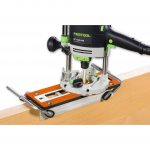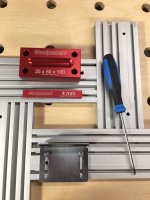benbo66 said:
rst:
1. In the above video the MFS seems to be supplied with some angles that the guy uses to secure/align the stock to the MFT...are these the kind of angles you referred to in your post?
rst/Cheese:
2. You both advise to use a shorter bit before a longer one but why would i not just start right up with a long one that can drill/rout to the depth that I want?
3. I've checked the 1/4 radius box and the 4 and 5 inch boxes (not sure why I'm excluding the 6 and 7 options - just a hunch but would that be correct?) and this presents me with 4 bits.
4. Which of these might I pick and why?...what do the flute number options mean? why flute up vs not flute up?
5. I'm supposing that the greater the cutting height, the deeper i can cut in one pass but why would you choose a shorter height vs a greater one?
6. Also the link you sent directs me to "Spiral Solid Carbide Router Bits" as opposed to non-spiral and non-carbide bits so why not those?
1. I believe [member=25351]rst[/member] modified some aluminum angle stock so that the angle brackets would be longer which would give him additional clamping options.
The steel angles that come with the MFS aren't very long and can hinder the placement of clamps. Here's a photo.
And here's an earlier thread on the issue.
https://www.festoolownersgroup.com/...-mfs-using-an-mfs-a-1010/msg575536/#msg575536
[attachimg=1]
2. If you purchase and install a 6" long router bit, you'll have 3" of the bit extending below the router base. Thus, you have to purchase a 3" long bit and route a pocket in the wood deep enough so that you can then install a longer router bit. This may take 2 router bits or it may take 3 router bits. It all depends upon how deep you want the mortice to be.
3. I'm assuming you're talking about search page for router bits on the Tools Today website.
https://www.toolstoday.com/router-b...t_by=relevency&disable_semantics=1&page_num=3
4. Flutes refer to the number of cutting edges. Use a 2-flute because it will core out its own hole. A down cut flute will push chips to the bottom of the cut. You want an up cut so that it pulls the chips up and out of the pocket.
5. There are limits on how deep you you can cut per router pass. The rule of thumb for depth of cut is 1X the diameter of the router bit, so a 1/2" diameter bit could be fed to a depth of 1/2". That applies to any length router bit, from 3" to 6" or any length in between.
However, for hard woods I wouldn't use the 1X factor, I'd go to a 1/2X or even 1/4X depending upon the hardness of the material. If you plunge too deep and attempt to cut, you'll burn the wood which heats up the router bit and dulls it quickly. Once you start to see any blued edges on the router bit it's basically toast.
6. A solid carbide spiral router bit will give you a cleaner cut than a carbide inserted straight bit. A HSS router bit will give you a shorter service life and should be avoided at all costs. They tend to burn easily, then they lose their sharpness and then they go to the scrapper. [smile]


